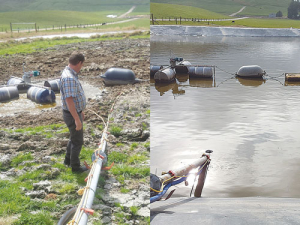$52,500 fine for effluent mismanagement
A Taupiri farming company has been convicted and fined $52,500 in the Hamilton District Court for the unlawful discharge of dairy effluent into the environment.
 David Law near the pond with a 1m-thick crust. The image, right, shows the same pond clear and crust-free after Law increased the pH and introduced aerobic bacteria.
David Law near the pond with a 1m-thick crust. The image, right, shows the same pond clear and crust-free after Law increased the pH and introduced aerobic bacteria.
Is your farm effluent ‘good’ or ‘bad’, and what makes it so in the first place? asks David Law, Forward Farming Biological Consultancy.
What is good effluent and what does it look like? he asks.
A healthy effluent pond is clear and free from crust. When irrigated to pasture, the effluent is light-to-clear in colour and has very little odour.
In contrast, an effluent pond with any form of crust on top shows that the effluent within is tending towards ‘poor’. Underneath the crust is a section of ‘dead water’ and at the bottom of the pond a sludgy build-up.
Poor effluent, which contains elevated levels of methane and nitric oxide as unprocessed solids, is dark and strong smelling when irrigated to pasture.
A pond sitting at rest with no stirring displays the true physical characteristics of the effluent. But it may be difficult to ‘read’ an effluent pond that uses a solids separator or a weeping wall system; in these cases, a pH test will show whether your pond is dominated by aerobic (good) or anaerobic (bad) bacteria.
Why is a healthy effluent pond free from crust and sludge?
The physical condition of the pond is dictated by the biological condition of the pond. The crust on a pond is feed that has not been digested by the cows.
In a healthy pond, aerobic bacteria thrive. They naturally digest these solids, or undigested feed, creating clear processed effluent that is ready for soil to absorb.
Raw (anaerobic) effluent contains solids which still need to break down before the effluent can be utilised by the soil, using valuable energy from the soil to break it down.
What conditions determine the health of the pond? This is determined by its pH levels, and which bacteria are thriving under those conditions; a pond with a pH of 7.4 is ideal, creating a crust-free pond dominated by aerobic bacteria.
In these ideal conditions, the aerobic bacteria digest the undigested feed presenting as crust and sludge.
“Aerobic and anaerobic bacteria have competitive exclusion: the further the pH drops below the equilibrium of pH 7, the thicker the crust and the higher the percentage of anaerobic bacteria,” Law says.
“In fact, you can calculate the pH of the pond by measuring the thickness of the crust.”
Law says contrary to popular belief stirring does not change the biological makeup of a pond; it only temporarily breaks up the crust.
“If your pond is anaerobic, aerating it is a waste of effort as there is no aerobic bacteria present to breathe the air,” he says.
“Stirring a pond, even for eight hours a day, will not change the pond from an anaerobic state to an aerobic state; it simply disrupts the job of the aerobic bacteria, which is to eat the crust and later the sludge.
“If the aerobic bugs are not present, in the case of a very low pH, you must change the pH to support the introduction of them in the short term, and follow up with a review of farm biology and systems.
“Research at Lancaster University has shown that an aerobic, crust-free pond produces 67% less greenhouse gas than a crusted pond; with this information available, farmers have to start thinking biologically.”
This email address is being protected from spambots. You need JavaScript enabled to view it.
Alliance has announced a series of capital raise roadshow event, starting on 29 September in Tuatapere, Southland.
State farmer Pāmu (Landcorp) has announced a new equity partnership in an effort to support pathways to farm ownership for livestock farm operators.
Following a recent overweight incursion that saw a Mid-Canterbury contractor cop a $12,150 fine, the rural contracting industry is calling time on what they consider to be outdated and unworkable regulations regarding weight and dimensions that they say are impeding their businesses.
Trade Minister Todd McClay says his officials plan to meet their US counterparts every month from now on to better understand how the 15% tariff issue there will play out, and try and get some certainty there for our exporters about the future.
Brett Wotton, an Eastern Bay of Plenty kiwifruit grower and harvest contractor, has won the 2025 Kiwifruit Innovation Award for his work to support lifting fruit quality across the industry.